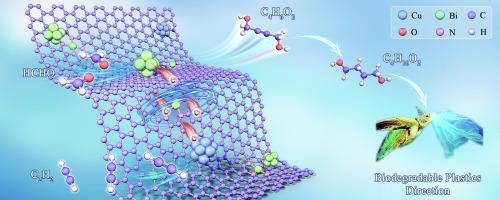Our official English website, www.x-mol.net, welcomes your
feedback! (Note: you will need to create a separate account there.)
Construction of a copper-bismuth catalyst featuring Bi-N4 sites and synergistic Bi clusters derived from TCPP(Bi)@HKUST-1 for enhanced formaldehyde to butynediol
Journal of Catalysis ( IF 6.5 ) Pub Date : 2024-11-10 , DOI: 10.1016/j.jcat.2024.115843 Yong Wang, Yongkang Sun, Fusheng Huang, Tingting Wang, Bin Dai, Jichang Liu, Jiangbing Li, Xuhong Guo
Journal of Catalysis ( IF 6.5 ) Pub Date : 2024-11-10 , DOI: 10.1016/j.jcat.2024.115843 Yong Wang, Yongkang Sun, Fusheng Huang, Tingting Wang, Bin Dai, Jichang Liu, Jiangbing Li, Xuhong Guo

|
The construction of functional catalysts that efficiently catalyze in a reducing atmosphere is considered rather challenging. In this study, the catalysts bridged by Bi-N4 between copper and bismuth species were prepared. Herein, Bi-N4 and bismuth cluster sites were incorporated into porous carbon–nitrogen networks along with copper nanoparticles (BiSAC&Clu -Cu-NC). For the synthesis, metalloporphyrin-modified HKUST-1 (TCPP(Bi)@HKUST-1) was employed as a precursor. Additionally, metalloporphyrin functioned as a capping agent during catalyst preparation, thereby enhancing the dispersion of Bi species after calcination. Notably, the BiSAC&Clu -Cu-NC catalyst demonstrated 93.8 % selectivity towards 1,4-butynediol over 20 h at a Bi loading of 0.6 wt% in a reducing atmosphere of acetylene and formaldehyde. Furthermore, a mechanistic model is proposed that elucidates the observed synergistic catalytic behavior based on experimental characterization and DFT calculations. This proposed model is termed “Nanoparticles with Cluster and Single Metal Sites”(NCS mechanism). The retention of the Bi cluster structure within the material matrix plays a pivotal role in enhancing the adsorption and activation of formaldehyde. Interfacial effects between different copper species favour the activation of the reaction substrate acetylene. Additionally, the Bi-N4 structure can function as a crucial conduit, facilitating electron transfer between Cu and Bi elements and consequently lowering the activation energy barrier for key reaction intermediates.
中文翻译:

构建具有 Bi-N4 位点和 TCPP(Bi)@HKUST-1 衍生的协同 Bi 簇的铜铋催化剂,用于增强甲醛制丁炔二醇
构建在还原气氛中有效催化的功能催化剂被认为相当具有挑战性。本研究制备了 Bi-N4 在铜和铋物种之间桥接的催化剂。在此,Bi-N4 和铋簇位点与铜纳米颗粒 (BiSAC&Clu-Cu-NC) 一起被掺入多孔碳-氮网络中。对于合成,采用金属卟啉改性的 HKUST-1 (TCPP(Bi)@HKUST-1) 作为前驱体。此外,金属卟啉在催化剂制备过程中起到封端剂的作用,从而增强了煅烧后 Bi 物种的分散性。值得注意的是,在乙炔和甲醛的还原气氛中,BiSAC&Clu-Cu-NC 催化剂在 0.6 wt% 的 Bi 负载量下,在 20 小时内对 1,4-丁炔二醇表现出 93.8% 的选择性。此外,提出了一个机理模型,该模型基于实验表征和 DFT 计算阐明观察到的协同催化行为。这个提出的模型被称为 “Nanoparticles with Cluster and Single Metal Sites (NCS mechanism)”。Bi 团簇结构在材料基质中的保留对增强甲醛的吸附和活化起着关键作用。不同铜种类之间的界面效应有利于反应底物乙炔的活化。此外,Bi-N4 结构可以作为一个关键的管道,促进 Cu 和 Bi 元素之间的电子转移,从而降低关键反应中间体的活化能垒。
更新日期:2024-11-10
中文翻译:

构建具有 Bi-N4 位点和 TCPP(Bi)@HKUST-1 衍生的协同 Bi 簇的铜铋催化剂,用于增强甲醛制丁炔二醇
构建在还原气氛中有效催化的功能催化剂被认为相当具有挑战性。本研究制备了 Bi-N4 在铜和铋物种之间桥接的催化剂。在此,Bi-N4 和铋簇位点与铜纳米颗粒 (BiSAC&Clu-Cu-NC) 一起被掺入多孔碳-氮网络中。对于合成,采用金属卟啉改性的 HKUST-1 (TCPP(Bi)@HKUST-1) 作为前驱体。此外,金属卟啉在催化剂制备过程中起到封端剂的作用,从而增强了煅烧后 Bi 物种的分散性。值得注意的是,在乙炔和甲醛的还原气氛中,BiSAC&Clu-Cu-NC 催化剂在 0.6 wt% 的 Bi 负载量下,在 20 小时内对 1,4-丁炔二醇表现出 93.8% 的选择性。此外,提出了一个机理模型,该模型基于实验表征和 DFT 计算阐明观察到的协同催化行为。这个提出的模型被称为 “Nanoparticles with Cluster and Single Metal Sites (NCS mechanism)”。Bi 团簇结构在材料基质中的保留对增强甲醛的吸附和活化起着关键作用。不同铜种类之间的界面效应有利于反应底物乙炔的活化。此外,Bi-N4 结构可以作为一个关键的管道,促进 Cu 和 Bi 元素之间的电子转移,从而降低关键反应中间体的活化能垒。






























 京公网安备 11010802027423号
京公网安备 11010802027423号